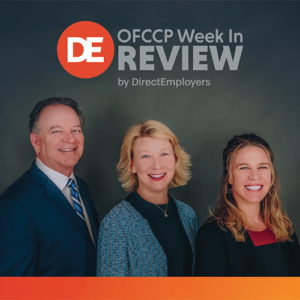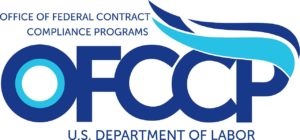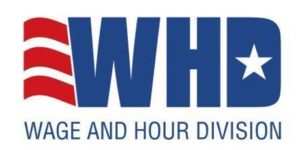
- OFCCP Corporate Scheduling Announcement List Posted
- VEVRAA Benchmark for Hiring Lowered
- ODEP Announced Apprenticeship Inclusion Models
- Good News! The Veteran Unemployment Rate Continues To Hit New Record Lows!
- NPRM to Update “Regular Rate” Regulations
- DE & ASE Seek to Intervene in the ‘EEO-1 Component 2 Pay Reporting’ Lawsuit to Advise the Court that Employers Cannot be Ready Until 2020
Monday, March 25, 2019: OFCCP Corporate Scheduling Announcement List Posted

of name from Corporate Scheduling Announcement “Letter” to Corporate Scheduling Announcement “List.”
NOTE: The first date that OFCCP would send any Compliance Evaluation Scheduling Letters to contractors from this CSAL would be 45 days after March 25 = MAY 9, 2019. We believe OFCCP has built this CSAL to go through approximately the end of FY 2020 (ending September 30, 2020) = 18 months from now.
By The Numbers
There are 3,500 establishments on this CSAL. The types of Compliance Evaluations include:
- 2345 Establishment Reviews (i.e., “regular audits”).
- 500 Section 503 Focused Reviews at corporate headquarters of multi-establishment companies that had the largest number of establishments, where possible per available OFCCP District Office. (This OFCCP evaluation tool is new with this CSAL, even though OFCCP’s Rules have allowed for it since 2000.)
- 500 Compliance Checks selected at the regional level directed at contractor establishments with the lowest employee counts. (OFCCP has resurrected these Compliance Checks from the grave after the Bush (the son) OFCCP killed and buried these 20-minute on-site investigations as too expensive to continue).
- 83 Corporate Management Compliance Evaluations (“CMCE,” or “Glass Ceiling Audits”). Two per OFCCP District Office and at contractor headquarter establishments of 300 or more employees, where possible. (This appears to be a doubling of the usual (about 42) CMCEs per Fiscal Year, except that this CSAL seems built to occupy OFCCP for 18 months.)
- 72 Functional Affirmative Action Program Reviews (“FAAP”). Three per OFCCP District Office directed at contractor establishments with the highest employee counts, where possible.
OFCCP also released FAQs and the scheduling methodology. Highlights from the scheduling methodology include:
Not included in this CSAL
- “Direct Establishments” (contractors with multiple contracts at a particular address) with fewer than 70 employees;
- “Associate Establishments” with fewer than 100 employees (these establishments are not signatory to a prime covered federal Government contract but, OFCCP has jurisdiction nonetheless because the company which operates/owns this establishment is a covered federal Government contractor);
- “Establishments” (contractors with one contract at a particular address) with an active separate facility exemption waiver;
- Healthcare establishments under the TRICARE Directive (DIR 2014-01);
- Universities;
- Establishments under a review or monitoring period;
- Establishments that have completed a review or monitoring period within the last two years;
- Establishments that are pending being scheduled for a review from a prior scheduling list;
- Independent subsidiaries of corporations that do not have contract coverage.
- Canceled contracts and contracts inactive over the last 15 months, contracts associated with debarred companies, contracts valued at less than $50,000;
- Contracts awarded to federal, state, local, municipal, tribal, city, and Foreign governments, and school districts
- Construction companies.
Thresholds for this CSAL
- No more than 15 establishments of any parent company;
- No more than five establishments of the same company per OFCCP District Office; and
- No more than two CMCEs and three FAAPs per OFCCP District
Return of Industry-Based Audits
Attributing OFCCP’s return to controversial “industry-based” compliance evaluations to a recommendation in the 2016 Government Accountability Office Report, this CSAL includes approximately one-third (1,167) of establishments in industries determined to have the highest rate of discrimination findings (agriculture, manufacturing, and wholesale trade). OFCCP identified these three industry targets from OFCCP’s review of prior Conciliation Agreements which included discrimination findings. OFCCP believes that past non-compliance will serve as the neutral criterion to justify any ensuing on-site audits without a warrant in satisfaction of the Fourth Amendment’s prohibition of unreasonable searches and seizures.
IMPORTANT NOTE: In the next fiscal year (starting October 1, 2020), OFCCP plans to incorporate VEVRAA Focused Reviews into its Corporate Scheduling Announcement List.
Wednesday, March 27, 2019: VEVRAA Benchmark for Hiring Lowered
Effective March 31, 2019, the benchmark for veteran hiring for federal government contractors will be 5.9%. Since its inception in 2014, the benchmark for hiring veterans has declined annually.
Annual VEVRAA Benchmark Effective Dates
| Percentage | Effective Date | |
| From | To | |
| 5.9 | 3/31/2019 | Present |
| 6.4 | 3/31/2018 | 3/31/2019 |
| 6.7 | 3/4/2017 | 3/30/2018 |
| 6.9 | 3/4/2016 | 3/30/2017 |
| 7.0 | 4/21/2015 | 3/3/2016 |
| 7.2 | 3/24/2014 | 4/20/2015 |
Thursday, March 28, 2019: ODEP Announced Apprenticeship Inclusion Models
The U.S. Department of Labor’s Office of Disability Employment Policy (“ODEP”) announced the selection of four organizations to pilot its Apprenticeship Inclusion Models’ (“AIM”) initiative. The purpose of the AIM initiative is to expand pathways for youth and adults with disabilities into high-demand, well-paying careers by developing and testing new recruitment and retention strategies with employers, unions, and apprenticeship programs.
The four organizations (two of which are DE Members) participating in the AIM initiative pilot are:
- Amazon
- Microsoft
- The Healthcare Career Advancement Program
- The Industrial Manufacturing Technician Apprenticeship Program
During a two-year period, these organizations will pilot inclusive apprenticeship programs to provide access to apprenticeship opportunities for youth and adults with disabilities.
As part of the AIM initiative, the participating pilot organizations will receive training and technical assistance from AIM partners to test innovative approaches to inclusive apprenticeship. In addition, AIM will build a national community of practice for interested practitioners and stakeholders to provide resources and gather feedback on developing inclusive apprenticeship programs.
The AIM initiative is a partnership between ODEP, Social Policy Research Associates, Ethos Strategic Consulting, and Jobs for the Future.
Thursday, March 28, 2019: Good News! The Veteran Unemployment Rate Continues to Hit New Record Lows!
The U.S. Department of Labor issued a news release summarizing a Bureau of Labor Statistics (“BLS”) Report regarding the Employment Situation of Veterans for 2018. Here are the highlights:
- The unemployment rate for female veterans declined to 3.0 percent in 2018, and the rate for male veterans (3.5 percent) changed little over the year. The unemployment rate for male veterans was not statistically different from the rate for female veterans.
- Among the 326,000 unemployed veterans in 2018, 54 percent were age 25 to 54, 40 percent were age 55 and over, and 6 percent were age 18 to 24.
- Veterans with a service-connected disability had an unemployment rate of 5.2 percent in August 2018, higher than the rate for veterans with no disability (3.5 percent).
- About 1 in 3 employed veterans with a service-connected disability worked in the public sector in August 2018, compared with about 1 in 5 veterans with no disability.
In 2018, the unemployment rate of veterans varied across the country, ranging from 1.4 percent in Iowa to 6.5 percent in the District of Columbia.
Friday, March 29, 2019: NPRM to Update “Regular Rate” Regulations

“Regular rate” requirements define what payments employers include as “wages” and include in the “time and one-half” calculation when determining workers’ overtime rates.
Under current rules, it is often unclear what payments are “wages” and whether or not to include them in the “regular rate of pay” when multiplying that “regular rate” by the OT premium payment percentage to determine the overtime pay rate (especially employee “perks” and payments which are not for “work”). The Proposed Rule focuses primarily on clarifying whether or not to include certain kinds of perks, benefits or other miscellaneous items in the regular rate. The Proposal also aims to better define the “regular rate” in light of today’s evolving workplace practices.
The Department proposes clarifications to confirm that employers may exclude the following from an employee’s “regular rate” of pay:
- The cost of providing wellness programs, onsite specialist treatment, gym access, fitness classes, and employee discounts on retail goods and services;
- Payments for unused paid leave, including paid sick leave;
- Reimbursed expenses, even if not incurred “solely” for the employer’s benefit;
- Reimbursed travel expenses that do not exceed the maximum travel reimbursement under the Federal Travel Regulation System and that satisfy other regulatory requirements;
- Discretionary bonuses;
- Benefit plans, including accident, unemployment, and legal services; and
- Tuition programs, such as reimbursement programs or repayment of educational debt.
The Proposed Rule also includes additional clarification about other forms of compensation, including payment for meal periods, “call back” pay, and others.
Additional Information
- Overtime Pay Website
- Fact Sheet: NPRM to Update the Regulations Governing the Regular Rate under the FLSA
- FAQs about the Proposed Rule
Deadline for comments is May 28, 2019.
Monday, April 2, 2019: DE & ASE Seek to Intervene in the ‘EEO-1 Component 2 Pay Reporting’ Lawsuit to Advise the Court that Employers Cannot be Ready Until 2020
Today, DirectEmployers (“DE”) and the American Society of Employers (“ASE”), together filed a Motion to make an appearance as “Amicus Curiae” (a friend of the court) in the federal District Court for the District of Columbia in the lawsuit the National Women’s Law Center (“NWLC”) and other plaintiffs have brought against the EEOC and the Office of Management and Budget (“OMB”). The NWLC’s lawsuit seeks to compel the Defendant federal agencies to require those employers which Title VII covers and employing 100 or more employees to file in coming weeks the so-called ‘Component 2’ portion of the EE0-1 Survey for 2018.
DE Survey Conclusion
DE Member responses to the DE Survey clearly show that the parties to the lawsuit have simply missed the 2018 reporting year for lack of enough forewarning to the employer community for the called-for ‘Component 2’ “hours worked” and “pay data” reporting.
NOTE: ‘Component 2’ reporting breaks into two parts:
- “Hours Worked” reporting, broken down by race, sex, and ethnicity for employees within each of the ten EEO-1 reporting categories and sorted within each of the 12 new pay bands; and
- “Pay Data” reporting, broken down by race, sex, and ethnicity within each of the -ten EEO-1 reporting categories and sorted within each of the 12 new pay bands.
DE and ASE also filed today with its Motion to Appear an Amicus Curiae Brief reporting to the Court the results of last week’s DE’s confidential Member Survey posing eight questions asking how soon Members could be ready to submit to the EEO-1 Survey reporting portal EEO-1 ‘Component 2’ “hours worked” and “pay data.”
We specially thank again our Members for responding so quickly and in such force to the survey (underscoring to us at DE the importance our Members attach to this pay reporting issue).
The full results of DE’s Member Survey are available to Members in the DE Community, preceded by the Declaration of Candee Chambers authenticating the Survey.
DE’s Member Survey Summary
- Requiring ‘Component 2’ reporting by May 31, 2019, is simply not possible for the vast majority of employers.
- “Hours Worked” Reporting
- 129 out of 178 employers (72.5%) responded that they would be UNABLE to report “hours worked” by May 31, 2019.
- Only 27.5% of employers reported their ability to provide the “hours worked” ‘Component 2 reporting’ data by May 31, 2019.
- 98 out of the 129 employers (76%) reported that they could NOT be ready to report by May 31, 2019, citing staffing limitations as an issue.
- 100 out of those same 129 employers (77.5%) also reported that they could NOT be ready to report by May 31, 2019, citing technology limitations (Members were free to denote either or both limitations as an issue).
Members unable to gather hours worked data before May 31, 2019, reported:
- The need to re-deploy staff members to design and undertake the needed reporting,
- Insufficient time to prepare the data,
- The need for customized computer programming,
- The need to acquire or build electronic and computerized data sorting tools,
- The need to create templates for upload,
- Reliance upon third-party payroll vendors for data,
- Difficulty gathering data because not centrally stored,
- Difficulty gathering data because stored on multiple electronic platforms,
- 107 out of 166 employers (64%) responded that they would need to start a new mid-budget year budget amendment process to obtain new budgetary allocations within the company to secure more IT/software, more data clean-up capabilities, and/or pay new vendor delivery fees to report “hours worked” data per ‘Component 2s’ reporting requirements, and
- 91 employers out of 121 (82%) who reported they were unable to report by May 30, 2019, also reported that they would need until the next EEO-1 Survey reporting cycle in 2020 to be able to report complete and accurate ‘Component 2’ “hours worked” data as part of the ‘Component 2’ reporting obligation. THIS IS IMPORTANT: 4 out of 5!
- “Pay Data” Reporting
- 113 out of 161 employers (70%) responded they would not be able to report the called for pay data by May 31, 2019.
- 30% of the employers noted an ability to report the total number of employees in each pay band for “pay data” purposes by May 31, 2019.
- 94 out of the 112 employers (84%) reported they could not be ready to report by May 31, 2019, cited staffing limitations as an issue, and
- 91 out of those same 112 employers (81%) cited technology limitations.
Members unable to gather pay data before May 31, 2019, reported:
- The need for customized computer programming,
- The need for customized data sorting tools,
- Reliance on payroll vendor reports,
- Having to manually obtain race, sex, and ethnicity information (since those are not normally part of payroll records).
- 105 out of 159 employers (66%) responded that they would need to start a new mid-budget year budget amendment process to obtain new budgetary allocations within the company to secure more IT/software, more data clean-up capabilities, and/or pay new vendor delivery fees to report pay data per ‘Component 2s’ reporting requirements.
- 91 employers out of 111 (82%) who reported they were unable to report by May 30, 2019, also reported that they would need until the next EEO-1 Survey reporting cycle in 2020 to be able to report complete and accurate ‘Component 2’ “pay data” as part of the ‘Component 2’ reporting obligation. THIS AGAIN IS IMPORTANT: 4 out of 5!
NOTE 1: The Court has already decided that the OMB’s withdrawal of the EEOC’s ‘Component 2’ reporting obligation was not lawful and that the EEOC must resume with its requirement to require ‘Component 2’ pay data reporting. So, this is not the time or place (yet) in the NWLC’s case against OMB and the EEOC for employers to attack the EEOC’s requirement that covered Title VII employers report ‘Component 2’ data. There is an opportunity (soon) down the road for such an employer legal attack on the EEOC Rule as arbitrary and capricious and otherwise not in accordance with the law. But that time has not yet arrived until the employer community has suffered injury. Indeed, the NWLC’s Court has thus far not ordered a date certain on which pay data reporting would be scheduled to begin (although the Court is positioning itself to do so as early as April 3rd when the EEOC must reveal the Agency’s plans to the Court to resume and require covered Title VII employers to report ‘Component 2’ pay data).
NOTE 2: The EEOC and OMB may decide to appeal the existing decision of the trial Court and to seek an injunction of the ‘Component 2’ reporting requirement during the pendency of the appeal. So, there could be a further “Stop” in the pay data reporting saga in the near future. The EEOC and OMB appear to have until May 3, 2019, to file an appeal of the District Court’s March 4, 2019 Order requiring ‘Component 2’ reporting to resume.
Fasten your seatbelts, it’s a roller coaster ride!
SUBSCRIBE.
Compliance Alerts
Compliance Tips
Week In Review (WIR)
Subscribe to receive alerts, news and updates on all things related to OFCCP compliance as it applies to federal contractors.
